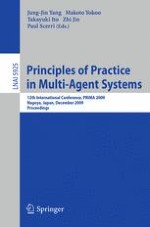Agents are software processes that perceive and act in an environment, processing their perceptions to make intelligent decisions about actions to achieve their goals. Multi-agent systems have multiple agents that work in the same environment to achieve either joint or conflicting goals. Agent computing and technology is an exciting, emerging paradigm expected to play a key role in many society-changing practices from disaster response to manufacturing to agriculture. Agent and mul- agent researchers are focused on building working systems that bring together a broad range of technical areas from market theory to software engineering to user interfaces. Agent systems are expected to operate in real-world environments, with all the challenges complex environments present. After 11 successful PRIMA workshops/conferences (Pacific-Rim International Conference/Workshop on Multi-Agents), PRIMA became a new conference titled “International Conference on Principles of Practice in Multi-Agent Systems” in 2009. With over 100 submissions, an acceptance rate for full papers of 25% and 50% for posters, a demonstration session, an industry track, a RoboCup competition and workshops and tutorials, PRIMA has become an important venue for multi-agent research. Papers submitted are from all parts of the world, though with a higher representation of Pacific Rim countries than other major multi-agent research forums. This volume presents 34 high-quality and exciting technical papers on multimedia research and an additional 18 poster papers that give brief views on exciting research.
